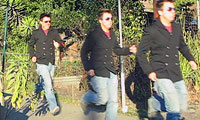
The processing of visual motion begins at the retina, where it is handled primarily by cells of the "magnocellular pathway." These cells send motion information to primary visual cortex via the lateral geniculate nucleus of the thalamus. Motion processing continues in cortex through several visual areas, ending up eventually in a region of temporal cortex called MT. Cells in MT respond to quite sophisticated aspects of motion, including motion in 3D and motion of animals. As is typical, the visual cortex of the left hemisphere of the brain processes information for the right visual field, and the right hemisphere processes the left visual field. A stroke to area MT in the left hemisphere can therefore impair the perception of motion in the right visual field, a condition known as hemi-akinetopsia. A patient suffering from hemi-akinetopsia has normal motion perception in one half, say the left half, of the visual field, but cannot see motion in the right half of the visual field. Instead, such a patient reports seeing the right half of the visual field as though it were viewed with a strobe light.


Moving objects in this field seem to appear in a sequence of static poses, with no smooth motion between the poses. This makes it difficult to perform basic visuo-motor tasks, such as pouring a cup of tea. For the stream of tea emerging from the pot and entering the cup appears to the hemi-achromatopsic as though it were frozen in space, and the fluid level in the cup does not appear to rise smoothly. Thus the hemi-achromatopsic cannot tell when enough tea has been poured, until it is too late, and tea is spilled all over the table. Similarly, a hemi-achromatopsic has trouble crossing a busy street, for they cannot see a smooth motion of oncoming cars, but instead see the cars first far away, and then suddenly near, with no smooth transition in between. Parties can be visually disturbing to a hemi-achromatopsic, for people seem to appear and disappear without warning. The condition of hemi-achromatopsia can be experienced temporarily by using transcranial magnetic stimulation (TMS) to interfere with the normal neural activity of area MT. When the magnetic field is turned on, neural processing of motion is inhibited, and one's perception of motion fails.